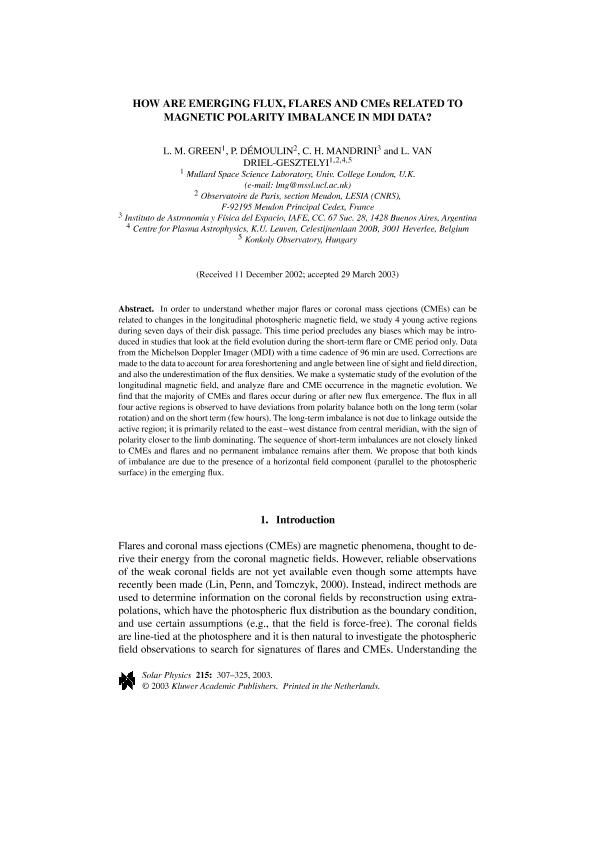Mostrar el registro sencillo del ítem
dc.contributor.author
Green, L. M.
dc.contributor.author
Démoulin, Pascal

dc.contributor.author
Mandrini, Cristina Hemilse

dc.contributor.author
van Driel Gesztelyi, Lidia

dc.date.available
2017-07-24T18:37:21Z
dc.date.issued
2003-12
dc.identifier.citation
Green, L. M.; Démoulin, Pascal; Mandrini, Cristina Hemilse; van Driel Gesztelyi, Lidia; How are emerging flux, flares and CMEs related to magnetic polarity imbalance in MDI data?; Springer; Solar Physics; 215; 2; 12-2003; 307-325
dc.identifier.issn
0038-0938
dc.identifier.uri
http://hdl.handle.net/11336/21180
dc.description.abstract
In order to understand whether major flares or coronal mass ejections (CMEs) can be related to changes in the longitudinal photospheric magnetic field, we study 4 young active regions during seven days of their disk passage. This time period precludes any biases which may be introduced in studies that look at the field evolution during the short-term flare or CME period only. Data from the Michelson Doppler Imager (MDI) with a time cadence of 96 min are used. Corrections are
made to the data to account for area foreshortening and angle between line of sight and field direction, and also the underestimation of the flux densities. We make a systematic study of the evolution of the longitudinal magnetic field, and analyze flare and CME occurrence in the magnetic evolution. We find that the majority of CMEs and flares occur during or after new flux emergence. The flux in all four active regions is observed to have deviations from polarity balance both on the long term (solar rotation) and on the short term (few hours). The long-term imbalance is not due to linkage outside the active region; it is primarily related to the east–west distance from central meridian, with the sign of polarity closer to the limb dominating. The sequence of short-term imbalances are not closely linked to CMEs and flares and no permanent imbalance remains after them. We propose that both kinds of imbalance are due to the presence of a horizontal field component (parallel to the photospheric surface) in the emerging flux.
dc.format
application/pdf
dc.language.iso
eng
dc.publisher
Springer

dc.rights
info:eu-repo/semantics/openAccess
dc.rights.uri
https://creativecommons.org/licenses/by-nc-sa/2.5/ar/
dc.subject
Flux
dc.subject.classification
Astronomía

dc.subject.classification
Ciencias Físicas

dc.subject.classification
CIENCIAS NATURALES Y EXACTAS

dc.title
How are emerging flux, flares and CMEs related to magnetic polarity imbalance in MDI data?
dc.type
info:eu-repo/semantics/article
dc.type
info:ar-repo/semantics/artículo
dc.type
info:eu-repo/semantics/publishedVersion
dc.date.updated
2017-07-24T14:12:33Z
dc.journal.volume
215
dc.journal.number
2
dc.journal.pagination
307-325
dc.journal.pais
Alemania

dc.journal.ciudad
Berlin
dc.description.fil
Fil: Green, L. M.. Mullard Space Science Laboratory; Reino Unido. University College London; Estados Unidos
dc.description.fil
Fil: Démoulin, Pascal. Centre National de la Recherche Scientifique. Observatoire de Paris; Francia
dc.description.fil
Fil: Mandrini, Cristina Hemilse. Consejo Nacional de Investigaciónes Científicas y Técnicas. Oficina de Coordinación Administrativa Ciudad Universitaria. Instituto de Astronomía y Física del Espacio. - Universidad de Buenos Aires. Facultad de Ciencias Exactas y Naturales. Instituto de Astronomía y Física del Espacio; Argentina
dc.description.fil
Fil: van Driel Gesztelyi, Lidia. Centre National de la Recherche Scientifique. Observatoire de Paris; Francia. University College London; Estados Unidos
dc.journal.title
Solar Physics

dc.relation.alternativeid
info:eu-repo/semantics/altIdentifier/url/https://link.springer.com/article/10.1023/A:1025678917086
Archivos asociados
